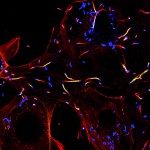Lien vers Pubmed [PMID] – 22684987
Eur. J. Immunol. 2012 Sep;42(9):2395-408
Using N-ethyl-N-nitrosourea-induced mutagenesis, we established a mouse model with a novel form of neutropenia resulting from a point mutation in the transcriptional repressor Growth Factor Independence 1 (Gfi1). These mice, called Genista, had normal viability and no weight loss, in contrast to mice expressing null alleles of the Gfi1 gene. Furthermore, the Genista mutation had a very limited impact on lymphopoiesis or on T- and B-cell function. Within the bone marrow (BM), the Genista mutation resulted in a slight increase of monopoiesis and in a block of terminal granulopoiesis. This block occurred just after the metamyelocytic stage and resulted in the generation of small numbers of atypical CD11b(+) Ly-6G(int) neutrophils, the nuclear morphology of which resembled that of mature WT neutrophils. Unexpectedly, once released from the BM, these atypical neutrophils contributed to induce mild forms of autoantibody-induced arthritis and of immune complex-mediated lung alveolitis. They additionally failed to provide resistance to acute bacterial infection. Our study demonstrates that a hypomorphic mutation in the Gfi1 transcriptional repressor results in a novel form of neutropenia characterized by a split pattern of functional responses, reflecting the distinct thresholds required for eliciting neutrophil-mediated inflammatory and anti-infectious responses.


